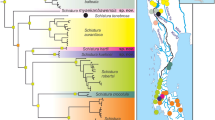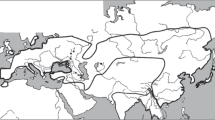Abstract
The pseudoxyrhophiine snake genus Liopholidophis Mocquard, 1904 (family Lamprophiidae) is endemic to Madagascar and according to its present definition comprises six medium-sized, terrestrial and diurnal snake species, most of which are characterised by an unusual and extreme sexual dimorphism in tail length. We performed molecular phylogenetic analyses using nucleotide sequences of three mitochondrial genes (16S rRNA, cytochrome b and cytochrome oxidase I) and one nuclear gene (c-mos) for all described and two additional species newly described herein. The two new species are very small sized (total length: 234–312.5 mm), have comparatively short tails and a reduced number of dorsal scale rows (15 at midbody), the lowest value among all non-scolecophidian snakes of Madagascar. Both species are secretive or rare, and they have a reddish belly in life that fades in preservative. In terms of colouration and morphology, they are most similar to each other and furthermore to Liopholidophis rhadinaea. Together with this species and L. dimorphus, they form a well-supported clade. Liopholidophis baderi sp. nov. from central eastern Madagascar is characterised by 149–158 ventrals and 71–77 subcaudals, whereas the similar L. oligolepis sp. nov. from the northeast has even fewer ventrals (137) and subcaudals (54). The phylogenetic tree suggests that the tail length dimorphism in the genus Liopholidophis has evolved in a complex pattern including at least one reversal. The phylogenetic position of the two new dwarf species indicates that both the absence of extreme sexual dimorphism in tail length and their body size reduction are derived and probably correlated features. Also the close phylogenetic relationships between the long-tailed L. sexlineatus and the similar but relatively short-tailed L. varius demonstrate that dimorphism in tail length can be strongly mitigated in short evolutionary time periods.





Similar content being viewed by others
References
Alexander, A. A., & Gans, C. (1966). The pattern of dermal-vertebral correlation in snakes and amphibians. Zoologische Mededelingen, 41, 171–190.
Andreone, F., Vences, M., Vieites, D. R., Glaw, F., & Meyer, A. (2005). Recurrent ecological adaptations revealed through a molecular analysis of the secretive cophyline frogs of Madagascar. Molecular Phylogenetics and Evolution, 34, 315–322.
Arnold, E. N. (1988). Caudal autotomy as a defence. In C. Gans & R. Huey (Eds.), Biology of the Reptilia (pp. 235–273). New York: Alan R. Liss.
Bauchot, R. (1997). Snakes: A Natural History. New York: Sterling Publishing Company
Cadle, J. E. (1996a). Snakes of the genus Liopholidophis (Colubridae) from eastern Madagascar: new species, revisionary notes and estimate of phylogeny. Bulletin of the Museum of Comparative Zoology, 154, 369–464.
Cadle, J. E. (1996b). Systematics of snakes of the genus Geodipsas (Colubridae) from Madagascar, with descriptions of new species and observations on natural history. Bulletin of the Museum of Comparative Zoology, 155, 33–87.
Cadle, J. E. (1998). The identity of Leptophis varius Fischer, 1884, and placement of Liopholidophis pinguis Parker, 1925, in its synonymy. Journal of Herpetology, 32, 434–437.
Cadle, J. E. (2003). Colubridae, snakes. In S. M. Goodman & J. P. Benstead (Eds.), The Natural History of Madagascar (pp. 997–1004). Chicago and London: The University of Chicago Press. 1709 pp.
Cadle, J. E. (2009). Sexual dimorphism and reproductive biology in the Malagasy snake genus Liopholidophis (Lamprophiidae: Pseudoxyrhophiinae). Proceedings of the California Academy of Sciences, 4(60), 461–502.
Chiari, Y., Ravelonkasina, D. M., & Faliarisoa, E. (2006). Liopholidophis sexlineatus (NCN). Distribution. Herpetological Review, 37, 363.
Clutton-Brock, T. (2007). Sexual selection in males and females. Science, 318, 1882–1885.
Crottini, A., Dordel, J., Köhler, J., Glaw, F., Schmitz, A., & Vences, M. (2009). A multilocus phylogeny of Malagasy scincid lizards elucidates the relationships of the fossorial genera Androngo and Cryptoscincus. Molecular Phylogenetics and Evolution, 53, 345–350.
Darwin, C. (1859). The origin of species by means of natural selection, or the preservation of favoured races in the struggle for life. London: John Murray, 1st edition.
Darwin, C. (1871). The descent of man, and selection in relation to sex (Vol. 1st edition). London: John Murray.
Domergue, C. A. (1988). Notes sur les serpents de la région malgache. VIII. Colubridae nouveaux. Bullettin Museum National Histoire Naturelle, 4(10), 135–146.
Dowling, H. G. (1951). A proposed standard system of counting ventrals in snakes. British Journal of Herpetology, 1, 97–99.
Emlen, D. J. (2008). The evolution of animal weapons. Annual Review of Ecology, Evolution, and Systematics, 39, 387–413.
Fisher, R. A. (1915). The evolution of sexual preference. Eugenics Review, 7, 184–192.
Franzen, M., Jones, J., Raselimanana, A. P., Nagy, Z. T., D'Cruze, N., Glaw, F., et al. (2009). A new black-bellied snake (Pseudoxyrhophiinae: Liophidium) from western Madagascar, with notes on the genus Pararhadinaea. Amphibia-Reptilia, 30, 173–183.
Glaw, F., Köhler, J., Townsend, T. M., & Vences, M. (2012). Rivaling the world's smallest reptiles: Discovery of miniaturized and microendemic new species of leaf chameleons (Brookesia) from northern Madagascar. PLoS ONE, 7, e31314.
Glaw, F., Nagy, Z. T., Franzen, M., & Vences, M. (2007). Molecular phylogeny and systematics of the pseudoxyrhophiine snake genus Liopholidophis (Reptilia, Colubridae): evolution of its exceptional sexual dimorphism and descriptions of new taxa. Zoologica Scripta, 36, 291–300.
Glaw, F., & Vences, M. (2007). A field guide to the amphibians and reptiles of Madagascar, third edition. Vences & Glaw Verlag, 496 pp.
Glaw, F., Vences, M., & Nussbaum, R. A. (2005). A new species of Heteroliodon (Reptilia: Squamata: Colubridae) from Montagne des Francais, far northern Madagascar. Herpetologica, 61, 275–280.
Harmon, L., Weir, J., Brock, G., Glor, R., Challenger, W., & Hunt, G. (2008). GEIGER: analysis of evolutionary diversification. R package version:, 1, 2–13.
Hawlitschek, O., Nagy, Z. T., & Glaw, F. (2012). Island evolution and systematic revision of Comoran snakes: why and when subspecies still make sense. PLoS ONE, 7, e42970.
Hedges, S. B. (2008). At the lower size limit in snakes: two new species of threadsnakes (Squamata: Leptotyphlopidae: Leptotyphlops) from the Lesser Antilles. Zootaxa, 1841, 1–30.
Hedges, S. B., & Thomas, R. (2001). At the lower size limit in amniotes: a new diminutive lizard from the West Indies. Caribbean Journal of Science, 37, 168–173.
Katoh, K., Misawa, K., Kuma, K., & Miyata, T. (2002). MAFFT: a novel method for rapid multiple sequence alignment based on fast Fourier transform. Nucleic Acids Research, 33, 511–518.
Katoh, K., & Toh, H. (2008). Improved accuracy of multiple ncRNA alignment by incorporating structural information into a MAFFT-based framework. BMC Bioinformatics, 9, 212.
King, R. B. (1989). Sexual dimorphism in snake tail length: sexual selection, natural selection, or morphological constraint? Biological Journal of the Linnean Society, 38, 133–154.
Kirkpatrick, M. (1987). Sexual selection by female choice in polygynous animals. Annual Review of Ecology and Systematics, 18, 43–70.
Lindell, L. E. (1994). The evolution of vertebral number and body size in snakes. Functional Ecology, 8, 708–719.
Maddison, W. P., & Maddison, D. R. (2009). Mesquite: A modular system for evolutionary analysis. Version 2.72. http://mesquiteproject.org.
Megson, S., Mitchell, P., & D’Cruze, N. (2009). Reptilia, Serpentes, Colubridae, Heteroliodon fohy: Distribution extension. Check List, 5, 692–694.
Mocquard, F. (1904). Description de quelques reptiles et d'un batracien nouveaux de la collection du Muséum. Bulletin du Muséum National d'Histoire Naturelle, 10, 301–309.
Nagy, Z. T., Glaw, F., Andreone, F., Wink, M., & Vences, M. (2007). Species boundaries in Malagasy snakes of the genus Madagascarophis (Serpentes: Colubridae sensu lato) assessed by nuclear and mitochondrial markers. Organisms, Diversity and Evolution, 7, 241–251.
Nagy, Z. T., Glaw, F., & Vences, M. (2010). Systematics of the snake genera Stenophis and Lycodryas (Squamata, Serpentes, Pseudoxyrhophiinae) from Madagascar and the Comoros. Zoologica Scripta, 39, 426–435.
Nagy, Z. T., Joger, U., Wink, M., Glaw, F., & Vences, M. (2003). Multiple colonization of Madagascar and Socotra by colubrid snakes: evidence from nuclear and mitochondrial gene phylogenies. Proceedings of the Royal Society London, B, 270, 2613–2621.
Nagy, Z. T., Sonet, G., Glaw, F., & Vences, M. (2012). First large-scale DNA barcoding assessment of reptiles in the biodiversity hotspot of Madagascar, based on newly designed COI primers. PLoS ONE, 7, e34506.
Paradis, E., Claude, J., & Strimmer, K. (2004). APE: analyses of phylogenetics and evolution in R language. Bioinformatics, 20, 289–290.
Petrie, M., Halliday, T., & Sanders, C. (1991). Peahens prefer peacocks with elaborate trains. Animal Behaviour, 41, 323–332.
Posada, D. (2008). jModelTest: Phylogenetic model averaging. Molecular Biology and Evolution, 25, 1253–1256.
R Development Core Team (2011). R: A language and environment for statistical computing. R Foundation for Statistical Computing, Vienna, Austria. ISBN 3-900051-07-0, http://www.R-project.org/.
Ramanamanjato, J.-B., Jenkins, R. K. B., & Randrianantoandro, C. J. (2007). Chapter 4.5. Conservation of a rare Malagasy snake: The case of Pseudoxyrhopus kely (family Colubridae). In J. U. Ganzhorn, S. M. Goodman, & M. Vincelette (Eds.), Biodiversity, Ecology and Conservation of Littoral Ecosystems in Southeastern Madagascar, Tolagnaro (Fort Dauphin) (pp. 167–179). Washington DC, USA: Smithsonian Institution. Series editor Alfonso Alonso. SI/MAB Series #11.
Rambaut, A., & Drummond, A. J. (2009). Tracer - MCMC Trace Analysis Tool, version 1.5.
Raxworthy, C. J., & Nussbaum, R. A. (1994). A review of the Madagascan snake genera Pseudoxyrhopus, Pararhadinaea, and Heteroliodon (Squamata: Colubridae). Miscellaneous Publications, Museum of Zoology, University of Michigan, 182, 1–37.
Ritchie, M. G. (2007). Sexual selection and speciation. Annual Review of Ecology, Evolution, and Systematics, 38, 79–102.
Rittmeyer, E. N., Allison, A., Gruendler, M. C., Thompson, D. K., & Austin, C. C. (2012). Ecological guild evolution and the discovery of the world’s smallest vertebrate. PLoS ONE, 7, e29797.
Ronquist, F., & Huelsenbeck, J. P. (2003). MrBayes 3: Bayesian phylogenetic inference under mixed models. Bioinformatics, 19, 1572–1574.
Sambrook, J., Fritsch, E. F., & Maniatis, T. (1989). Molecular Cloning: A Laboratory Manual. New York: Cold Spring Harbor Laboratory.
Shine, R. (1978). Sexual size dimorphism and male combat in snakes. Oecologia, 33, 269–277.
Shine, S. (1989). Ecological causes for the evolution of sexual dimorphism: a review of the evidence. The Quarterly Review of Biology, 64(4), 419–461.
Shine, R. (1994). Sexual size dimorphism in snakes revised. Copeia, 1994, 326–364.
Shine, R., Olsson, M. M., Moore, I. T., LeMaster, M. P., & Mason, R. T. (1999). Why do male snakes have longer tales than females? Proceedings of the Royal Society London, B, 266, 2147–2151.
Shine, R., & Shetty, S. (2001). The influence of natural selection and sexual selection on the tails of sea-snakes (Laticauda colubrina). Biological Journal of the Linnean Society, 74, 121–129.
Schmitz, A., Brandley, M. C., Mausfeld, P., Vences, M., Glaw, F., Nussbaum, R. A., et al. (2005). Opening the black box: phylogenetics and morphological evolution of the Malagasy fossorial lizards of the subfamily "Scincinae". Molecular Phylogenetics and Evolution, 34, 118–133.
Swofford, D. L. (2002). PAUP*. Phylogenetic Analysis Using Parsimony (*and other methods), Version 4. Sunderland, Massachusets: Sinauer Associates.
Townsend, T. M., Tolley, K. A., Glaw, F., Böhme, W., & Vences, M. (2011). Eastward from Africa: palaeocurrent-mediated chameleon dispersal to the Seychelles islands. Biology Letters, 7, 225–228.
Zahavi, A. (1975). Mate selection – selection for a handicap. Journal of Theoretical Biology, 53, 205–214.
Zahavi, A. (1977). The cost of honesty (Further remarks on the handicap principle). Journal of Theoretical Biology, 67, 603–605.
Acknowledgements
We wish to thank Philip-Sebastian Gehring, Jörn Köhler, Konrad Mebert, Maciej Pabijan, Roger-Daniel Randrianiaina and David R. Vieites for their help in the field, Rainer Dolch for sharing his knowledge of the snakes of the Andasibe region, and Wolfgang Böhme (ZFMK) and Ivan Ineich (MNHN) for the loan of snakes. Many thanks to Ruth Kühbandner (ZSM) for the excellent head drawings of the new species. We are grateful to the Madagascan authorities for research and export permits. The fieldwork was supported by the Volkswagen Stiftung.
Author information
Authors and Affiliations
Corresponding author
Rights and permissions
About this article
Cite this article
Glaw, F., Kucharzewski, C., Nagy, Z.T. et al. New insights into the systematics and molecular phylogeny of the Malagasy snake genus Liopholidophis suggest at least one rapid reversal of extreme sexual dimorphism in tail length. Org Divers Evol 14, 121–132 (2014). https://doi.org/10.1007/s13127-013-0152-4
Received:
Accepted:
Published:
Issue Date:
DOI: https://doi.org/10.1007/s13127-013-0152-4




